How to accept online payments in South Africa: A business guide
October 31, 2025Payment fraud has been a growing problem for South African SMBs/SMEs for years now. And with the rise of artificial intelligence (AI), fraudsters are now using sophisticated methods. That’s why your business needs to invest in top-tier payment fraud prevention tactics for safeguarding.
According to a SABRIC report, digital banking fraud rose by 45% in 2023, with banking app fraud being a dominant threat. That’s an alarming statistic, one that all businesses should take seriously. If you’re looking for proactive ways to fight against fraud, you’re in the right place.
This guide helps you identify payment fraud risks and shares solid advice on how to mitigate them. It covers the most popular types of payment fraud, how they can affect your business, and how you can set yourself up to be protected against revenue losses and reputation damage.
PS: Find out how our risk reports can help reduce business risk.
Protect your business before fraudsters strike
— explore smarter fraud prevention today.
What is payment fraud?
Payment fraud is the illegal and unauthorised process of manipulating transactions to receive, spend, or transfer money. This conduct compromises financial transactions and threatens the security of customers’ and businesses’ information, leading to losses and reputational damage.
It’s crucial for business owners to understand the nature of payment fraud so that they can counter it more effectively. Due to the growing sophistication of cybercrime, eCommerce businesses are more vulnerable to online payment fraud. About 4.9% of digital transactions were flagged as suspicious in the first half of 2024, with eCommerce, telecommunications, and financial services being the primary target sectors.
7 common types of payment fraud
Now, let’s take a closer look at the most common types of payment fraud in South Africa.
1. Card-related fraud
Card fraud happens when someone uses stolen card details to make unauthorised payments or withdrawals. For merchants, especially those operating online, this type of fraud can quickly lead to chargebacks, lost revenue, and damaged trust with customers. Card-not-present (CNP) fraud is the biggest concern, making up 68% of gross fraud losses.
Here are the common types and how they impact businesses:
- Counterfeit card fraud: Criminals clone a card’s magnetic strip and use it to make purchases. For in-store merchants, this can mean unknowingly accepting payments with a fake card and losing both the goods and the payment when the fraud is reported.
- Lost and/or stolen card fraud: A card that goes missing can be used before the cardholder even realises. If fraudsters shop at your store (online or physical), your business ends up processing a sale that will later be reversed.
- Card-not-present fraud: The biggest threat for online businesses. Fraudsters use stolen card details to shop on your website, and once the real cardholder disputes the transaction, the merchant bears the financial loss and additional administrative costs.
This is why online businesses need secure payment verification tools in place. Using a gateway like Netcash helps detect suspicious transactions early, reducing the chances of fraudulent card payments slipping through.
2. Social engineering fraud
Social engineering fraud happens when criminals manipulate people into handing over information or approving transactions. For online businesses, this is particularly risky because fraudsters often target your customers, and when their accounts or payments are compromised, your business may be left carrying the cost.
Here are the most common types and how they can affect merchants:
- Phishing: Fraudsters pose as a trusted brand (like your business) and send fake emails to customers, tricking them into sharing banking details or card numbers. When the stolen data is later used for fraudulent purchases, you face chargebacks and reputational harm.
- Vishing: Criminals call your customers pretending to be from your business, asking them to “verify” card or OTP details. If a purchase is made fraudulently with that information, you’re the one who may lose both the product and the payment.
- Smishing: Customers receive SMS messages that appear to be delivery updates or promotions from your store. These messages often contain links to malware that steal login or card information, which is then used to make unauthorised purchases on your site.
The challenge is that social engineering exploits human trust, which is harder to detect than technical breaches. This makes it essential to have a payment gateway like Netcash, which helps verify transactions, monitor suspicious activity, and mitigate the impact of fraud before it affects your business.
3. Identity theft fraud
Identity theft isn’t just a personal issue; it can create major risks for your business as well. When fraudsters steal someone’s personal details, like an ID number or banking information, they often use them to commit payment fraud against merchants, especially in online transactions.
For example:
- Account takeover fraud: Criminals may use stolen login details to break into a customer’s online profile, make unauthorised purchases, or redirect deliveries. This leaves your business dealing with chargebacks and financial losses.
- False application fraud: Fraudsters can apply for credit, open new accounts, or purchase products under someone else’s identity. If your business processes these payments without proper checks, you could end up losing money when the fraud is uncovered.
For online businesses, the cost isn’t just the lost sale; it’s also the time, admin, and reputational damage that follows. That’s why it’s essential to have secure fraud detection measures in place.
A secure payment gateway, such as Netcash, comes into play here. It protects merchants by screening transactions, verifying details, and reducing the risk of fraudulent payments slipping through.
4. Business email compromise (BEC) fraud
BEC fraud is a highly advanced crime where fraudsters impersonate SMEs executives or partners and trick senior employees into sending money or divulging sensitive information.
They often conduct in-depth research on their target on platforms such as LinkedIn or the business website, particularly the “About Us”, “Partners”, or “Brands We Work With” pages. Once they have this information, they send false emails or intercept authentic ones from suppliers, then substitute the account details with their own, siphoning off the SMBs’ funds.
This type of fraud relies on social engineering tactics, using the trust and authoritative stature of an executive to psychologically manipulate employees into making fraudulent transfers.
Here are some examples of business email compromise fraud:
- CEO fraud: This is when fraudsters impersonate a business CEO, sending an urgent request to a senior financial officer or human resources manager to make a transfer or hand over confidential business information.
- Fake invoice fraud: This occurs when perpetrators send falsified invoices to your business, convincing you to pay for goods or services that were never ordered or delivered. They often pretend to be legitimate suppliers or vendors, or alter real invoices with the intention of diverting payments to their bank accounts.
5. Investment fraud
Investment fraud is when scammers deceive businesses into transferring money, often promising high returns with little or no risk, which is typically unrealistic. Small businesses are highly at risk, as they usually need funds to scale, train staff, and acquire assets with high ROI.
As a business owner, some red flags to look out for include urgency, unauthorised by the Financial Sector Conduct Authority (FSCA), a request for crypto payment, and inflated returns.
6. Card skimming fraud at ATMs or point-of-sale devices
Card skimming is when fraudsters insert a small, often concealed skimming device into a card reader at ATMs or POS devices, secretly copying the data from the magnetic strip. Unknown actors usually perpetrate ATM card skimming, while POS device card skimming is unfortunately done by people close to the business, often employees or criminals acting as customers.
As a business owner, you can counteract this by reducing the reliance on POS devices as a payment method. Leverage cardless methods such as Scan To Pay and digital wallets.
7. Chargeback fraud
Chargeback fraud occurs when a customer or a scammer using stolen card details disputes a transaction with their bank, requiring a payment reversal from the business’s account. This results in the SME losing both the transaction amount and the goods or services it provided.
When a real customer initiates this, it is called “friendly fraud”, and sometimes people will do this to take advantage of the chargeback system. For your business, it’s essential to put in place several measures to avoid chargebacks or resolve them to mitigate the potential losses.

Payment fraud prevention techniques & tips to strengthen security
Here are a few tips you can implement to prevent payment fraud as a business in South Africa.
- Use secure payment systems: Choose payment methods that provide strong encryption, tokenisation, and robust fraud detection tools.
- Enable real-time payment tracking and monitoring: Adopt solutions that proactively monitor all payment channels and flag high-risk transactions before processing.
- Apply multi-factor authentication (MFA): Require two or more forms of verification for sensitive transactions and account access.
- Leverage device recognition and/or fingerprinting tools: Detect and block fraud attempts from unfamiliar or suspicious devices.
- Analyse behavioural patterns: Analyse customer and employee transaction behaviour to spot anomalies and trigger alerts on deviations.
- Conduct regular internal audits: Routinely review processes and conduct fraud risk assessments to identify vulnerabilities and strengthen controls.
- Focus on employee training and awareness: Educate staff on fraud risks, legal requirements, and warning signs, especially for phishing and social engineering attacks.
- Verify details and invoice authenticity: Double-check payment recipients and ensure invoice details and banking information are legitimate before sending funds.
- Stay compliant: Adhere to local regulations such as POPIA, PCCAA, FICA, and the Companies Act to secure business processes and data.
- Encourage quick reporting: Provide accessible channels for employees and customers to report suspicious or unauthorised transactions.
- Choose PCI DSS-compliant payment providers: Partner with platforms that meet international security standards for processing card payments.
- Use a layered security approach: Combine rule-based, AI-driven, and predictive analytic systems to tackle emerging fraud risks.
Don’t let payment fraud eat into your revenue.
Learn how to safeguard your business now.
Understanding PCI DSS compliance
Let’s start with the basics: what is PCI DSS? The acronym stands for Payment Card Industry Data Security Standard. It’s a set of security requirements aimed at protecting cardholder data. You can think of it as a guideline on how to securely shield users’ data from malicious breaches.
If your business stores, processes, or transmits cardholder data, then PCI DSS compliance means you must employ security controls to protect that information.
This table details the twelve PCI DSS requirements for compliance and their importance.
|
Control Objective |
PCI DSS Requirement |
Why It’s Important for Businesses/Merchants |
|
Build and maintain a secure network and systems |
1. Install and maintain a firewall to protect cardholder data |
Firewalls act as the first line of defence, blocking unauthorised access from external networks. |
|
|
2. Do not use vendor-supplied defaults for system passwords and other security parameters |
Default credentials are widely known; changing them reduces the risk of easy compromise. |
|
Protect cardholder data |
3. Protect stored cardholder data |
Prevents attackers from retrieving and misusing sensitive information in the event of a system breach. |
|
|
4. Encrypt transmission of cardholder data across open, public networks |
Encryption ensures that intercepted data (e.g., on public Wi-Fi) cannot be read or exploited. |
|
Maintain a vulnerability management program |
5. Protect all systems against malware and regularly update antivirus software |
Shields systems from malicious software that can steal or damage data. |
|
|
6. Develop and maintain secure systems and applications |
Regular patching and secure coding practices prevent exploitation of software flaws. |
|
Implement strong access control measures |
7. Restrict access to cardholder data by business need-to-know |
Minimises risk by granting data access only to employees who genuinely need it. |
|
|
8. Assign a unique ID to each person with computer access |
Creates accountability and enables activity tracking in the event of breaches. |
|
|
9. Restrict physical access to cardholder data |
Protects servers, payment terminals, and documents from theft or tampering. |
|
Regularly Monitor and Test Networks |
10. Track and monitor all access to network resources and cardholder data |
Monitoring logs detects suspicious activity and supports incident investigations. |
|
|
11. Regularly test security systems and processes |
Routine testing uncovers vulnerabilities before attackers exploit them. |
|
Maintain an information security policy |
12. Maintain a policy that addresses information security for all personnel |
Ensures staff understand their security responsibilities, reducing human error and negligence. |
How Netcash helps facilitate secure online payments
Here’s how Netcash can help your business stay in compliance with PCI DSS and beyond.
- PCI DSS compliant systems: Netcash follows the industry’s gold standard for protecting cardholder data. We are PCI DSS Level 1 Compliant, which processes over six million card transactions annually and faces the strictest requirements.
- Tokenisation and encryption: Customer payment details are encrypted and stored securely, reducing exposure to fraud.
- Multi-layered authentication: Tools like 3D Secure add extra protection against unauthorised card use.
- Fraud monitoring tools: Real-time alerts and monitoring help flag suspicious transactions.
- Secure integrations: Whether you use eCommerce platforms, invoicing, or payment links, security is built into every transaction.
- Dedicated support: Netcash provides guidance on setting up secure payment processes for your business.

Frequently Asked Questions
Payment fraud detection and prevention: wrapped up
As payments in South Africa evolve, scams become more sophisticated and advanced. By implementing fraud detection and prevention measures, you not only protect your customers’ personal data but also safeguard yourself against revenue losses and reputational damage.
Preventing fraud is about more than just protecting transactions; it’s about building trust with your customers. By combining best practices with a secure payment partner like Netcash, you can reduce risks, protect sensitive data, and focus on growing your business
Speak to a Payments Advisor today and see how we can help you with your online venture.

Lisanne is the Head of Risk, Legal, and Compliance at Netcash, where she provides strategic oversight across these critical functions. With a passion for ethical conduct and a keen eye for detail, she ensures the company operates within the highest regulatory standards. Lisanne’s strong analytical skills and ability to navigate complex challenges make her a valuable asset in mitigating risks and driving compliance. When she's not steering the company's legal course, she enjoys unwinding with a good book, exploring her creative side through painting, staying active with walks and gym sessions, or simply spending quality time with her beloved pets.


